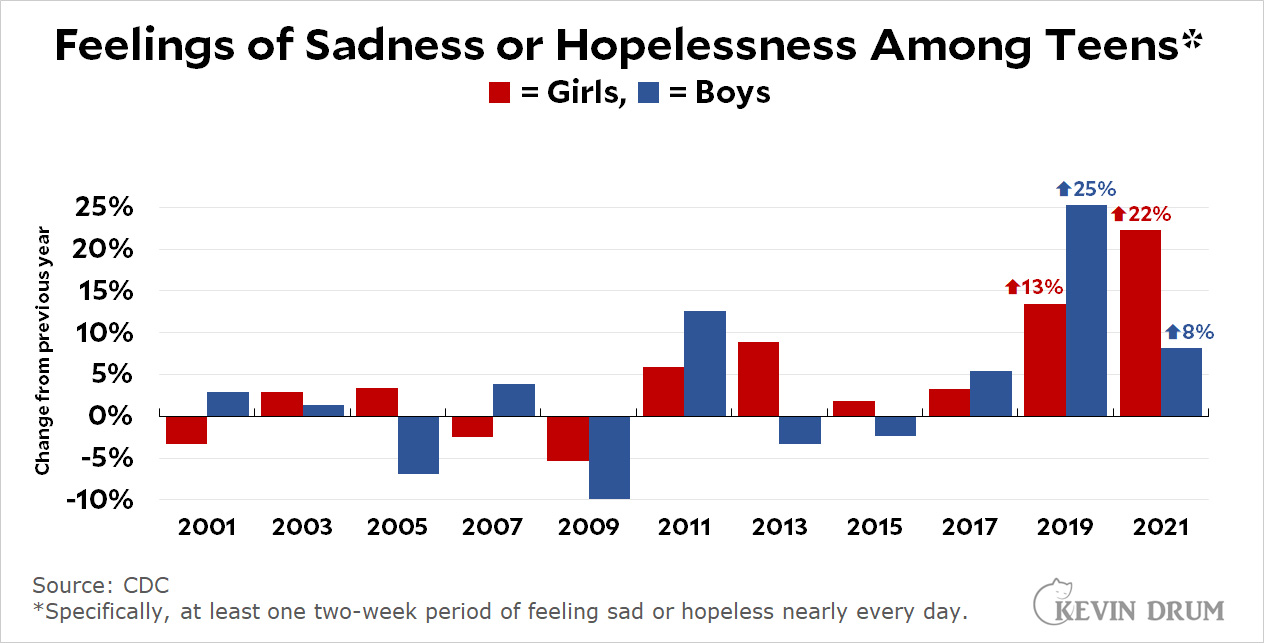Yesterday I was reading a column in the Washington Post by Kate Woodsome about the mental health of American teenagers, and it was, as usual, startling. American teens seem to be in terrible shape. In particular, Woodsome shared a CDC chart showing that more than half of teen girls experience "persistent feelings of sadness or hopelessness." Half! That seems hardly believable.
I traced this back to its source in order to get a longer-term view, and then, instead of looking at raw levels I looked at the change from year to year. Here it is:
 For the most part, the numbers go up and down and don't change a great deal—until 2019 and 2021. In the space of just four years, it jumps by a third for both boys and girls.
For the most part, the numbers go up and down and don't change a great deal—until 2019 and 2021. In the space of just four years, it jumps by a third for both boys and girls.
This is jaw dropping. Nothing changes that much unless there's some kind of serious external change driving it. But what?
It's not social media since everything was fairly stable for the entire century until 2019. (Though maybe the culprit is one specific bit of social media that started up around 2017?)
It's not COVID since it started before the pandemic.
It's not George Floyd, which happened in 2020.
It's not video games.
But what is it? The only thing that comes to mind is mass shootings, which do seem to have gotten considerably worse lately. Another possibility, as it always is, is some kind of statistical malfunction.
Any other ideas? What could have happened around 2018-19 that would have sent American teens literally off the deep end?
POSTSCRIPT: The full CDC report is here. For what it's worth, bullying has been stable lately. Threats of violence and sexual violence were steady. Sexual behavior was unchanged. Drug and alcohol use was mostly either stable or down. The answer probably lies somewhere else.

As I think about it I think school shootings are probably the key topic for teenagers.
What the deal is with that then leads them to every other issue that can't be dealt with.
Yeah, I'm guessing the increase in school shootings and the complete inability of the people in charge to do anything about it except tell them to barricade themselves in the classroom is a big concern.
When I see poll data like this, swinging wildly without any apparent explanation, my response is that the survey methodology must be fundamentally flawed. .
Parkland was five years ago. That's the first thing that comes to mind. And we elected Donald Trump.
Pingback: Another look at the epidemic of depression among teen girls – Kevin Drum
The constant threat of gun violence in our society….kids are particularly vulnerable. An inept and compromised congress; obviously lying politicians; a corrupt Supreme Court; the rise yet again of racism and misogyny; religious belief as currently marketed an uninteresting fossil; our inability to deal with the evolving climate crisis. You name it.
At the bottom of it all is a country in which everything is for sale To the highest bidder. It’s hard not to be cynical.
Pingback: Yet another look at social media and teen depression – Kevin Drum
I am glad to see so many commenters pointing out that changes in survey methodology or instrument need to be ruled out as a cause of surprising results, before one attempts to explain the observations.
I am guessing these data are from the Youth Risk Behavior Survey (YRBS), which is administered in school to a random sample of middle- and high-school students every other year. There is up to a six-year age difference between the oldest and youngest respondents each year. To understand what is going on here, you probably need to do a cohort analysis, not just a period analysis. You need to look at kids born in 2002, 2003, 2004 etc and look at the pattern of answers over time in each cohort as they get older. You get a family of curves, which may all be the same or may be different. Until you understand the cohort effects, and whether there was a change in survey methodology, and also learn which age group(s) have the biggest survey-to-survey change in their answers to the questions of interest, you probably should not try to interpret the data.